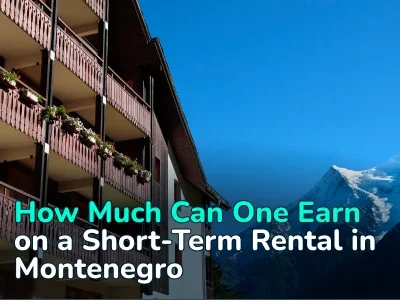
“It's more expensive than regular rentals, but there are benefits.” All about trendy coliving spaces: expert commentary and personal experience
Coliving has been a recent favorite living format for millennials and digital nomads. We learned more about this format and its characteristics, and we connected with a digital nomad who shared her experiences living in co-living spaces with us.
Previously, we wrote an article in which the architect told us in detail about new housing formats and spaces of the future, among which was the coliving.
When and where did coliving come into being? How is life arranged there? How are coliving houses different from communal flats and hostels? All these questions will be answered by the expert in the first part of our material; in the second part, you can learn about the personal experience of a digital nomad: why she likes the coliving format, what communities she has been in, and how much money is spent each month on this kind of living.
“The idea of co-living is not new, but it is again a very relevant format.”
Maria Onuchina, CEO of the hotel operator 25/7, told us about the coliving format in detail.

— Coliving—what is this accommodation format and what are its distinguishing features?
— Coliving is a variant of renting, where people who are connected by a common project, field of activity, or hobby live together. This format of living is based on micro-living—minimal personal space, which is compensated by a developed common infrastructure: recreation areas, co-working spaces, educational events, and entertainment events.
— When and in connection with what did this format originate?
— There are several well-known projects that became the ancestors of this trend. The prototypes of coliving spaces began to appear in Britain in the 1930s. Intellectuals and expats lived in the Isokon space in England. In addition to bedrooms, residents had access to laundry facilities, a restaurant, and a rooftop terrace. The price to stay in such a mansion was quite high. And with the impact of the crisis on the cost of real estate, the format of such coliving spaces began to spread more and more.
The Rainbow Mansion in Cupertino, California, in 2006 became closer to the modern version of coliving. It was founded by five friends who came to work at the Ames Research Center at NASA and rented a mansion to save money. As a result, the house turned from a place of residence into a place of exchange of ideas, a kind of club of like-minded people. The project is still in existence today.
The pandemic also gave a tremendous impetus to the development of coliving spaces—people needed an environment where they could live together and continue to work on projects.
— What distinguishes a coliving space from a communal apartment?
— Unlike communal apartments or dormitories, which solve the issue of saving money, coliving is just about a very comfortable and stylish space in which, in addition to organized housing, the rental price includes a co-working area, full room service, a community, and a full training and entertainment schedule.
— How is coliving life organized? What is essential to know?
— Such a house is a place for co-creation, comfortable interaction, and concentration on projects. Coliving can take on two different formats: an open one in which anyone can rent a home, making it a place to meet people who share similar interests; or a closed one in which all residents are linked by a single project. Everything that makes it easier for people to communicate and form new friendships and partnerships is very valuable here.
— What should coliving include?
— A coliving space includes a resident's own living room or rooms, as well as common areas such as a café, co-working space, and sports area. In more modern projects, it may be a cinema, a swimming pool, or even a separate SPA complex. The management company shall undertake the payment of utility bills, security, repairs, cleaning of the premises, and concierge service.
In modern, high-quality projects, the work of a community manager is necessarily included, who will be responsible for organizing an atmosphere favorable to acquaintance and creativity.
— How common is this format of living in the world at the moment? Maybe there are countries where it is most popular?
— Most projects can be found in Los Angeles, San Francisco, Thailand, Malta, and Mexico. This format is popular among members of the technological and creative professions.
— What are the benefits of coliving? And what, conversely, are the disadvantages?
— A coliving can be a small mansion or a skyscraper with fitness areas, lounges, SPAs, and co-working spaces. You can live, work, socialize, and relax in a coliving community without dealing with everyday issues or wasting time on the road.
On the downside, this format of living with like-minded people is still common within metropolitan areas, as coliving is a relatively new trend prevalent within large cities. Although it is likely that in the near future, this format will appear in the regions, as a special offer for employees of corporations.
— Who is the target audience for coliving?
— Firstly, millennials and later generations are interested in this type of cohabitation. In the twenty-first century, there are more singles; young people have become more self-sufficient, start careers earlier, start families later, and are in general less in need of strong social ties. Nevertheless, communication is necessary, and such housing formats provide an opportunity for fruitful communication with like-minded people but also privacy. So the idea of co-living is not a new format, but it is very relevant again.
— Is it expensive to live in colivings? How does the payment system work?
— Living in a coliving project can be 10-15% more expensive than renting an apartment, but this 15% includes numerous additional options, a high level of service, and rich events, which makes the project very profitable to live in.
As a rule, residents enter into individual leases, which means that the tenant is only responsible for their part of the property, only for their fees, and so on.
“I really like the active spirit in co-livings.”
Maria aka Bulgarian Mermaid shared her experience of living in a coliving format with us:
— I was born in Bulgaria and raised around the world. I've been a digital nomad for the past 5 years, living out of a suitcase and working with projects within the US and Europe. I specialize in Digital Marketing and Operations Management for Tourism, Travel, Luxury Hospitality, Outdoor Adventure and Extreme Sports brands.
The first place I lived in the coliving format was Coworking Bansko in Bulgaria—it's still my favorite community in the whole world, where I made some incredibly cool friends.


Since I settled in Bansko coliving 3 years ago, I have lived in a coliving format in Portugal (Ericeira and the Algarve), Spain (Tenerife, Lanzarote, Tarife), Montenegro, and Greece on a yacht. I currently live in Amarilla Coliving in Tenerife and love the place and the community.
The cost of living in coliving: from €500 per month in the most affordable destinations to €1500 per month in the more expensive ones.
I love the coliving format: I love the community of like-minded professionals, the shared experience, the daily activities, the active spirit, and the excitement of meeting new people and interacting with them!


Author
I am responsible for editorial work. I write expert interviews and guides.





















